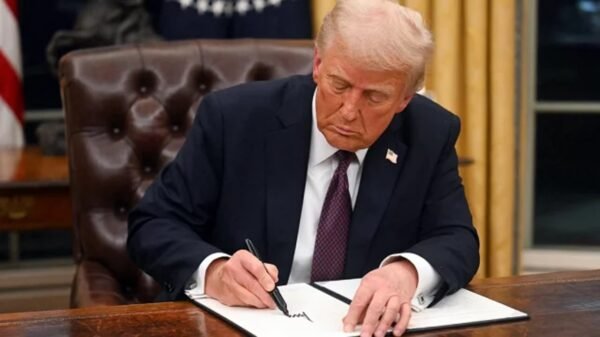Executive orders Trump signed on Day 1 in office

On January 20, 2025, shortly after being inaugurated as the 47th President of the United States, Donald Trump signed a significant number of executive orders aimed at reversing many policies implemented by the previous administration and advancing his own agenda. Here’s a summary of the key actions taken on his first day:
Key Executive Orders Signed by Trump
Withdrawal from the Paris Agreement
Trump formally withdrew the U.S. from the Paris climate agreement, echoing his previous term’s actions, which he argued were necessary to prioritize American energy interests.
Exit from the World Health Organization (WHO)
He signed an order pulling the U.S. out of the WHO, citing concerns over financial imbalances and alleged mismanagement during the COVID-19 pandemic.
End of Work-from-Home Policies
An executive order mandated that all federal employees return to in-person work full-time, effectively ending remote work arrangements that became common during the pandemic.
Federal Hiring Freeze
Trump instituted a hiring freeze across federal agencies, with exceptions for national security and public safety positions, to reduce government size and ensure competent hiring.
Crackdown on Immigration
He announced measures to tighten immigration controls, including attempts to end birthright citizenship for children of illegal immigrants and deploying military resources for border enforcement.
National Energy Emergency Declaration
Trump declared a national energy emergency to promote oil and gas development in the U.S., aiming to boost domestic production and reduce reliance on foreign energy sources.
Pardons Related to January 6 Insurrection
He signed pardons for approximately 1,500 individuals convicted in connection with the January 6 Capitol riot, reflecting his continued support for those involved.
Delay on TikTok Ban
An executive order was issued to delay a ban on TikTok by at least 75 days, allowing his administration time to evaluate its future.
Revocation of Biden-era Policies
Trump repealed numerous executive orders from Biden’s administration, including those related to LGBTQ+ protections and diversity initiatives within federal agencies.
Removal of Cuba from Terrorism List
He reversed Biden’s designation of Cuba as a state sponsor of terrorism, which had significant diplomatic implications.
These actions reflect Trump’s commitment to implementing an “America First” policy framework and signify a stark shift in U.S. governance priorities following his inauguration.
On January 20, 2025, Donald Trump signed a significant number of executive orders shortly after being inaugurated as the 47th President of the United States. His actions on Day 1 were aimed at reversing many policies from the previous administration and implementing his own agenda. Here’s a detailed overview of the key executive orders signed by Trump on his first day in office:
Key Executive Orders Signed on Day 1
Immigration and Border Security
National Emergency Declaration: Trump declared a national emergency at the U.S.-Mexico border to facilitate funding for border security initiatives, including the deployment of U.S. troops to assist immigration enforcement.
Birthright Citizenship: An executive order was issued to limit birthright citizenship, stating that children born in the U.S. to illegal immigrants would not automatically receive citizenship.
Asylum Policy Changes: Trump announced plans to reinstate the “Remain in Mexico” policy, requiring asylum seekers to wait outside the U.S. while their claims are processed.
Energy Policy
Withdrawal from the Paris Agreement: Trump signed an order to withdraw the United States from the Paris Climate Accord, a move he had previously enacted during his first term.
Energy Emergency Declaration: An executive order was issued declaring a national energy emergency, aimed at promoting oil and gas production and reducing regulatory barriers for energy projects, particularly in Alaska.
Federal Operations and Employment
Return to In-Person Work for Federal Employees: Trump mandated that all federal employees return to in-person work full-time, reversing remote work policies implemented during the COVID-19 pandemic.
Creation of the Department of Government Efficiency (DOGE): This new department aims to streamline government operations and cut spending. It is co-led by Elon Musk, although some details about its structure remain unclear.
Schedule F Reinstatement: Trump reimplemented Schedule F, which allows for the removal of job protections for certain federal employees, making it easier to dismiss them for political reasons.
Social Policies
Gender Recognition Policy: An executive order was signed stating that the federal government would recognize only two genders—male and female—based on biological sex at birth. This order also affects how federal facilities manage gender-segregated spaces.
Diversity, Equity, and Inclusion (DEI) Programs: Trump directed an end to DEI initiatives within federal agencies, aligning with his campaign promises to roll back such programs.
Pardons
Pardons Related to January 6 Riots: Trump signed orders pardoning individuals convicted of crimes related to the January 6 Capitol riots. This includes dropping charges against many rioters and restoring voting rights for some.
Miscellaneous Orders
Naming Changes: Trump ordered changes to names of geographical entities, including renaming Denali back to Mount McKinley and changing the Gulf of Mexico to the Gulf of America—though these actions may face legal challenges regarding their authority.
Flags at Full Staff on Inauguration Day: An order was issued requiring flags to be flown at full staff during future Inauguration Days, following a recent precedent set by former President Jimmy Carter’s passing.
These executive orders reflect Trump’s commitment to implementing a conservative agenda focused on immigration control, energy independence, and reversing previous administration policies. The breadth of these actions indicates an aggressive start to his second term in office.
